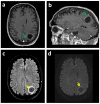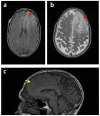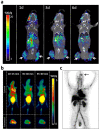Diagnosis of Glioblastoma by Immuno-Positron Emission Tomography
- PMID: 35008238
- PMCID: PMC8750680
- DOI: 10.3390/cancers14010074
Diagnosis of Glioblastoma by Immuno-Positron Emission Tomography
Abstract
Neuroimaging has transformed neuro-oncology and the way that glioblastoma is diagnosed and treated. Magnetic Resonance Imaging (MRI) is the most widely used non-invasive technique in the primary diagnosis of glioblastoma. Although MRI provides very powerful anatomical information, it has proven to be of limited value for diagnosing glioblastomas in some situations. The final diagnosis requires a brain biopsy that may not depict the high intratumoral heterogeneity present in this tumor type. The revolution in "cancer-omics" is transforming the molecular classification of gliomas. However, many of the clinically relevant alterations revealed by these studies have not yet been integrated into the clinical management of patients, in part due to the lack of non-invasive biomarker-based imaging tools. An innovative option for biomarker identification in vivo is termed "immunotargeted imaging". By merging the high target specificity of antibodies with the high spatial resolution, sensitivity, and quantitative capabilities of positron emission tomography (PET), "Immuno-PET" allows us to conduct the non-invasive diagnosis and monitoring of patients over time using antibody-based probes as an in vivo, integrated, quantifiable, 3D, full-body "immunohistochemistry" in patients. This review provides the state of the art of immuno-PET applications and future perspectives on this imaging approach for glioblastoma.
Keywords: antibody; diagnostic imaging; glioblastoma; immuno-PET; molecular imaging; nanobody; neuroimaging; theragnostic probes.
Conflict of interest statement
The authors declare no conflict of interest.
Figures






Similar articles
-
Diagnosis of Pancreatic Ductal Adenocarcinoma by Immuno-Positron Emission Tomography.J Clin Med. 2021 Mar 10;10(6):1151. doi: 10.3390/jcm10061151. J Clin Med. 2021. PMID: 33801810 Free PMC article. Review.
-
Nanobodies targeting ABCC3 for immunotargeted applications in glioblastoma.Sci Rep. 2022 Dec 30;12(1):22581. doi: 10.1038/s41598-022-27161-3. Sci Rep. 2022. PMID: 36585418 Free PMC article.
-
More advantages in detecting bone and soft tissue metastases from prostate cancer using 18F-PSMA PET/CT.Hell J Nucl Med. 2019 Jan-Apr;22(1):6-9. doi: 10.1967/s002449910952. Epub 2019 Mar 7. Hell J Nucl Med. 2019. PMID: 30843003
-
Immuno-Positron Emission Tomography with Zirconium-89-Labeled Monoclonal Antibodies in Oncology: What Can We Learn from Initial Clinical Trials?Front Pharmacol. 2016 May 24;7:131. doi: 10.3389/fphar.2016.00131. eCollection 2016. Front Pharmacol. 2016. PMID: 27252651 Free PMC article. Review.
-
IDH-wildtype glioblastomas and grade III/IV IDH-mutant gliomas show elevated tracer uptake in fibroblast activation protein-specific PET/CT.Eur J Nucl Med Mol Imaging. 2019 Nov;46(12):2569-2580. doi: 10.1007/s00259-019-04444-y. Epub 2019 Aug 6. Eur J Nucl Med Mol Imaging. 2019. PMID: 31388723
Cited by
-
ImmunoPET Directed to the Brain: A New Tool for Preclinical and Clinical Neuroscience.Biomolecules. 2023 Jan 13;13(1):164. doi: 10.3390/biom13010164. Biomolecules. 2023. PMID: 36671549 Free PMC article. Review.
-
Single-Domain Antibodies as Antibody-Drug Conjugates: From Promise to Practice-A Systematic Review.Cancers (Basel). 2024 Jul 27;16(15):2681. doi: 10.3390/cancers16152681. Cancers (Basel). 2024. PMID: 39123409 Free PMC article. Review.
-
Epidemiology, Diagnostic Strategies, and Therapeutic Advances in Diffuse Midline Glioma.J Clin Med. 2023 Aug 12;12(16):5261. doi: 10.3390/jcm12165261. J Clin Med. 2023. PMID: 37629304 Free PMC article. Review.
-
Unlocking glioblastoma: breakthroughs in molecular mechanisms and next-generation therapies.Med Oncol. 2025 Jun 21;42(7):276. doi: 10.1007/s12032-025-02830-1. Med Oncol. 2025. PMID: 40542948 Free PMC article. Review.
-
Performance of 18 F-FAPI PET/CT in assessing glioblastoma before radiotherapy: a pilot study.BMC Med Imaging. 2022 Dec 24;22(1):226. doi: 10.1186/s12880-022-00952-w. BMC Med Imaging. 2022. PMID: 36566187 Free PMC article.
References
-
- Verhaak R.G.W., Hoadley K.A., Purdom E., Wang V., Qi Y., Wilkerson M.D., Miller C.R., Ding L., Golub T., Mesirov J.P., et al. Integrated Genomic Analysis Identifies Clinically Relevant Subtypes of Glioblastoma Characterized by Abnormalities in PDGFRA, IDH1, EGFR, and NF1. Cancer Cell. 2010;17:98–110. doi: 10.1016/j.ccr.2009.12.020. - DOI - PMC - PubMed
-
- Deb P., Sharma M.C., Mahapatra A.K., Agarwal D., Sarkar C. Glioblastoma multiforme with long term survival. Neurol. India. 2005;53:329–332. - PubMed
Publication types
Grants and funding
- PI18/01665/Instituto de Salud Carlos III
- XIII Beca FERO en Investigación Oncológica Traslacional/Fundación FERO
- I Ayuda a la investigación del cáncer infantil/Asociación de Padres de Niños con Cáncer de Aragón (ASPANOA)
- PRDAR17002RUIZ/Asociación Española Contra el Cáncer
- PRDAR18006MEND/Asociación Española Contra el Cáncer
LinkOut - more resources
Full Text Sources

